Newsstand Period 1922 - 1955
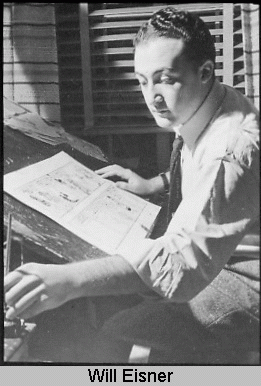 In 1939 Will Eisner would have Iger buy out his half of the comic
shop. Will left to join the Quality Comics Group and do a weekly comic
to be a part of newspapers. The newspapers wanted one specifically to
compete against the comic books.
It began in June of 1940, the main feature was Eisner's The Spirit.
Also in the booklet were back up stories of Eisner's
Lady Luck and Bob Powell's Mr. Mystic. One of the reasons Will was hired
because of his speed. The newspapers wanted a 16 page comic every week,
with The Spirit taking 8 of those pages. A "good" artist
could do a page a day. While Eisner was a fast artist, he did have
assistants helping him out. Oddly, the newspapers wanted
specifically a Superhero comic book, Eisner gave them the Spirit
instead. With the exception of the mask (which Eisner hated drawing)
the character wasn’t super powered. He was a normal detective thought
to be dead and he would let the world continue to believe that. By being "dead" he could
operate outside the law in fighting crime. That said he often visited
the police station with the chief knowing who he was.
In 1939 Will Eisner would have Iger buy out his half of the comic
shop. Will left to join the Quality Comics Group and do a weekly comic
to be a part of newspapers. The newspapers wanted one specifically to
compete against the comic books.
It began in June of 1940, the main feature was Eisner's The Spirit.
Also in the booklet were back up stories of Eisner's
Lady Luck and Bob Powell's Mr. Mystic. One of the reasons Will was hired
because of his speed. The newspapers wanted a 16 page comic every week,
with The Spirit taking 8 of those pages. A "good" artist
could do a page a day. While Eisner was a fast artist, he did have
assistants helping him out. Oddly, the newspapers wanted
specifically a Superhero comic book, Eisner gave them the Spirit
instead. With the exception of the mask (which Eisner hated drawing)
the character wasn’t super powered. He was a normal detective thought
to be dead and he would let the world continue to believe that. By being "dead" he could
operate outside the law in fighting crime. That said he often visited
the police station with the chief knowing who he was.
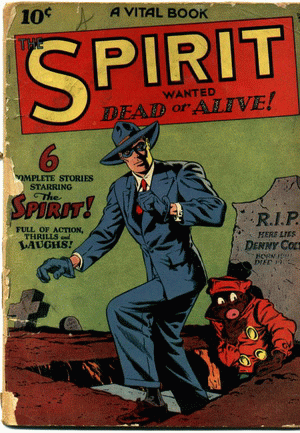 Eisner's work in The Spirit would
teach other artists about the different ways to draw
comics. This is particularly important as comic books were regularly
put down as a medium for children and illiterates. Most felt they were not worth any
serious examination to how and why the medium works. And this was by
the comic artists, writers and publishers! Eisner was pretty much alone
at this time in thinking comics could (and should) be something more
than crudely drawn, factory produced, brainless material grinded out
for the kids to read. Not only did he think that, he *showed* us that
it could be something different with the Spirit. Being in the newspapers the work would be aimed
at adult audiences. Eisner was also able to keep the rights to the
character, which would keep the character in print in comic books long
after the newspaper series ended. With this comic Eisner would
experiment with layout, design, storytelling techniques and as a result
would keep the booklet popular for 12 years. Among the other
publishers to print the Spirit would be Quality, Fiction House, Harvey Comics, Warren
Publishing, Kitchen Sink and DC Comics. The characters first appearance
in normal comic books would be in Quality’s
Police Comics #11
(September 1942). The Spirit would get a dedicated comic from Quality Comics in 1944
(shown here). It would go 22 issues ending in 1950.
Eisner's work in The Spirit would
teach other artists about the different ways to draw
comics. This is particularly important as comic books were regularly
put down as a medium for children and illiterates. Most felt they were not worth any
serious examination to how and why the medium works. And this was by
the comic artists, writers and publishers! Eisner was pretty much alone
at this time in thinking comics could (and should) be something more
than crudely drawn, factory produced, brainless material grinded out
for the kids to read. Not only did he think that, he *showed* us that
it could be something different with the Spirit. Being in the newspapers the work would be aimed
at adult audiences. Eisner was also able to keep the rights to the
character, which would keep the character in print in comic books long
after the newspaper series ended. With this comic Eisner would
experiment with layout, design, storytelling techniques and as a result
would keep the booklet popular for 12 years. Among the other
publishers to print the Spirit would be Quality, Fiction House, Harvey Comics, Warren
Publishing, Kitchen Sink and DC Comics. The characters first appearance
in normal comic books would be in Quality’s
Police Comics #11
(September 1942). The Spirit would get a dedicated comic from Quality Comics in 1944
(shown here). It would go 22 issues ending in 1950.
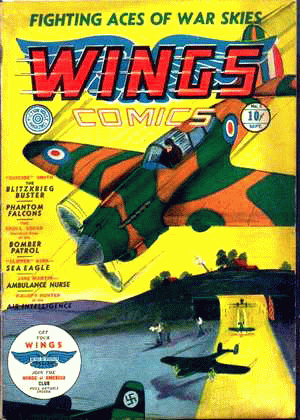 Wings Comics #1 came out from Fiction House in September 1940. It
would be devoted to Aviation stories. The comics were good for their
attention to details, which helped make the comic successful with Aviation
fans. This series would have a variety of reoccurring characters but
none that would be stable throughout the entire series run. The
features that would be most popular include Suicide Smith, Jane Martin,
Clipper Kirk, Grease Monkey Griffin, The Skull Squad, Captain Wings and
Phantom Falcons. The comic would go 124 issues ending in 1954.
Wings Comics #1 came out from Fiction House in September 1940. It
would be devoted to Aviation stories. The comics were good for their
attention to details, which helped make the comic successful with Aviation
fans. This series would have a variety of reoccurring characters but
none that would be stable throughout the entire series run. The
features that would be most popular include Suicide Smith, Jane Martin,
Clipper Kirk, Grease Monkey Griffin, The Skull Squad, Captain Wings and
Phantom Falcons. The comic would go 124 issues ending in 1954.
Wings Comics #1 is in the public domain and you can download and read it by clicking here. (32.1 MB - Scanned Microfiche)
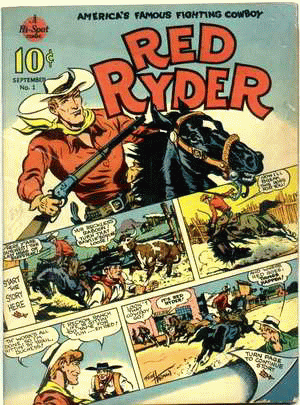 Red Ryder from Hawley Publications also came out in
September 1940. It would be the first successful western newsstand
comic book. Red Ryder was a comic strip done by Fred Harman, the same
artist would end up also drawing and doing covers for this series. With
issue #3 it would be taken over by Dell Publishing Co and after 151
issues it would be added into their 4 Color Comics Series. The success
of this title and others westerns would convince other publishers to do
westerns once the superhero books fell out of flavor.
Red Ryder from Hawley Publications also came out in
September 1940. It would be the first successful western newsstand
comic book. Red Ryder was a comic strip done by Fred Harman, the same
artist would end up also drawing and doing covers for this series. With
issue #3 it would be taken over by Dell Publishing Co and after 151
issues it would be added into their 4 Color Comics Series. The success
of this title and others westerns would convince other publishers to do
westerns once the superhero books fell out of flavor.
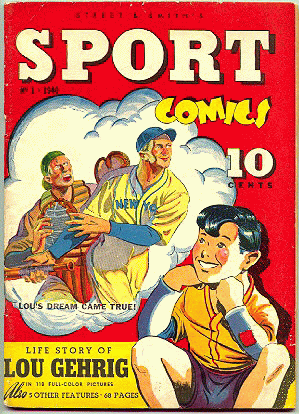 Street and Smith would produce Sport Comics #1 in September of
1940. This genre of true sport comics would be tried by many
publishers, often devoted to a popular athlete. This issue was main
feature was baseball star Lou Gehrig. But putting the thrill of a live
sport into a comic just did not translate very well. Virtually all
sport related comics had very limited runs.
Street and Smith would produce Sport Comics #1 in September of
1940. This genre of true sport comics would be tried by many
publishers, often devoted to a popular athlete. This issue was main
feature was baseball star Lou Gehrig. But putting the thrill of a live
sport into a comic just did not translate very well. Virtually all
sport related comics had very limited runs.
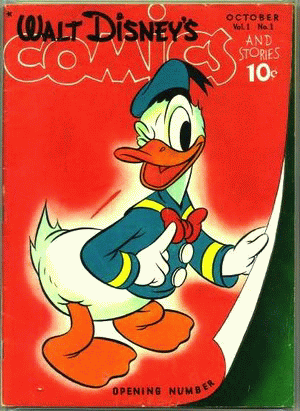 Walt Disney's Comics & Stories came out in October 1940 and
was unquestionable the worlds most widely read comic book of it’s time,
if not ever. The publisher was Western Printing and Lithography who
first signed a deal with Dell Comics (1-263), then published it
themselves through a company called Gold Key (263-473), then Whitman
(another branch of Western Printing) took over (474-510). Then another publisher named Gladstone (511-547) picked up the title. In 1990
Disney decided to self publish the title themselves (548-585) then gave the rights
back to Gladstone (586- 634). The comic stopped for some time but
Gladstone got the rights again as of 2002. The comic is still selling
very well in Europe. It would originally start with comic strip
reprints of Donald Duck by Al Taliaferro and Mickey Mouse by Floyd
Gottfredson. With issue #24 they started doing new stories of Donald
Duck. Then another duck artist came along and helped the title, more
about him later.
Walt Disney's Comics & Stories came out in October 1940 and
was unquestionable the worlds most widely read comic book of it’s time,
if not ever. The publisher was Western Printing and Lithography who
first signed a deal with Dell Comics (1-263), then published it
themselves through a company called Gold Key (263-473), then Whitman
(another branch of Western Printing) took over (474-510). Then another publisher named Gladstone (511-547) picked up the title. In 1990
Disney decided to self publish the title themselves (548-585) then gave the rights
back to Gladstone (586- 634). The comic stopped for some time but
Gladstone got the rights again as of 2002. The comic is still selling
very well in Europe. It would originally start with comic strip
reprints of Donald Duck by Al Taliaferro and Mickey Mouse by Floyd
Gottfredson. With issue #24 they started doing new stories of Donald
Duck. Then another duck artist came along and helped the title, more
about him later.
 In 1939 Will Eisner would have Iger buy out his half of the comic
shop. Will left to join the Quality Comics Group and do a weekly comic
to be a part of newspapers. The newspapers wanted one specifically to
compete against the comic books.
It began in June of 1940, the main feature was Eisner's The Spirit.
Also in the booklet were back up stories of Eisner's
Lady Luck and Bob Powell's Mr. Mystic. One of the reasons Will was hired
because of his speed. The newspapers wanted a 16 page comic every week,
with The Spirit taking 8 of those pages. A "good" artist
could do a page a day. While Eisner was a fast artist, he did have
assistants helping him out. Oddly, the newspapers wanted
specifically a Superhero comic book, Eisner gave them the Spirit
instead. With the exception of the mask (which Eisner hated drawing)
the character wasn’t super powered. He was a normal detective thought
to be dead and he would let the world continue to believe that. By being "dead" he could
operate outside the law in fighting crime. That said he often visited
the police station with the chief knowing who he was.
In 1939 Will Eisner would have Iger buy out his half of the comic
shop. Will left to join the Quality Comics Group and do a weekly comic
to be a part of newspapers. The newspapers wanted one specifically to
compete against the comic books.
It began in June of 1940, the main feature was Eisner's The Spirit.
Also in the booklet were back up stories of Eisner's
Lady Luck and Bob Powell's Mr. Mystic. One of the reasons Will was hired
because of his speed. The newspapers wanted a 16 page comic every week,
with The Spirit taking 8 of those pages. A "good" artist
could do a page a day. While Eisner was a fast artist, he did have
assistants helping him out. Oddly, the newspapers wanted
specifically a Superhero comic book, Eisner gave them the Spirit
instead. With the exception of the mask (which Eisner hated drawing)
the character wasn’t super powered. He was a normal detective thought
to be dead and he would let the world continue to believe that. By being "dead" he could
operate outside the law in fighting crime. That said he often visited
the police station with the chief knowing who he was. 


 Street and Smith would produce Sport Comics #1 in September of
1940. This genre of true sport comics would be tried by many
publishers, often devoted to a popular athlete. This issue was main
feature was baseball star Lou Gehrig. But putting the thrill of a live
sport into a comic just did not translate very well. Virtually all
sport related comics had very limited runs.
Street and Smith would produce Sport Comics #1 in September of
1940. This genre of true sport comics would be tried by many
publishers, often devoted to a popular athlete. This issue was main
feature was baseball star Lou Gehrig. But putting the thrill of a live
sport into a comic just did not translate very well. Virtually all
sport related comics had very limited runs. 
